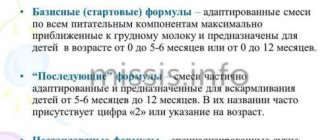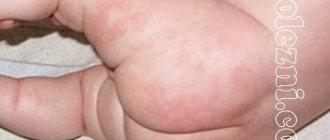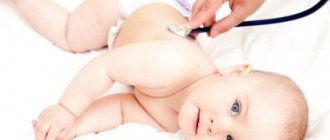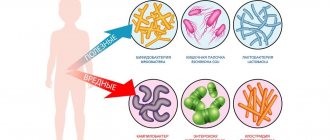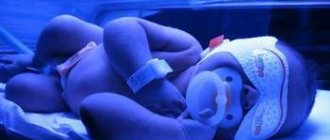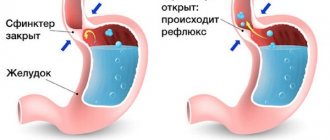Find the difference
Lactase is an enzyme that breaks down lactose into its components in the gastrointestinal tract for further absorption.
Lactose is milk sugar, which forms the basis of all carbohydrates in absolutely any milk, including breast milk.
A deficiency of this enzyme in a child's body (lactase deficiency) leads to impaired absorption of lactose and poor tolerance to foods containing milk sugar (lactose intolerance).
Signs and symptoms of milk and lactose intolerance in children
Signs of intolerance are in many ways similar to an allergic reaction, although there are some differences.
| Body department | Symptoms | General signs |
| Gastrointestinal tract |
| Your baby has milk intolerance, then pay attention: if the baby has diarrhea with streaks of blood, a lot of mucus, or signs of dehydration, you should immediately exclude any milk or formula from the diet and consult a doctor ! |
| Leather |
| The danger of these symptoms is due to the risk of angioedema, which can become life-threatening. Any rash should also cause alarm if it spreads at an alarming rate. |
| Airways |
| Cough resembling barking, wheezing, whistling breathing - all these signs can be signals of the onset of pulmonary obstruction or false croup. |
It is important to know! If you stop giving milk as food, secondary milk intolerance may disappear and the baby, after a course of treatment, may well eat dairy products and dishes made from milk without harming his health.
The main signs of lactase deficiency
- The child's anxiety when feeding milk, bloating, increased gas formation, diarrhea - these are the typical symptoms of this disease. After each feeding, liquid stool flows like a fountain due to strong fermentation - yellow, sour-smelling, foamy, more than 8-10 times a day, directly related to food intake.
- The child gains or loses weight poorly and is developmentally delayed.
- The stool resembles yeast dough: if you collect it in a glass container and let it stand, it separates into fractions: liquid and denser.
It must be borne in mind that when using disposable diapers, the liquid part is absorbed into them, and then stool abnormalities may not be noticed.
Symptoms usually increase with increasing volume of milk consumed. At first, in the first weeks of a newborn’s life, there are no signs of abnormalities at all. Then increased gas formation appears, even later - abdominal pain and only then - loose stools.
The clinical picture of the disease is individual for each child and may differ slightly. Sometimes there may be only isolated symptoms, but there is always a clear connection between diarrhea and milk consumption.
Medical nutrition
If alactasia is confirmed, the only treatment is complete and lifelong abstinence from milk in any form and dairy products. Babies are transferred to artificial feeding with special formulas. Such lactose-free options can be found among the mixtures Nan, “Babushkino Lukoshko”, “Nutrilon”, etc. Usually on their packaging you can see the abbreviations “BL” or “FL”. For hypolactasia, low-lactose mixtures are prescribed.
Subsequently, such patients should beware of sources of hidden lactose (they may contain whole, powdered or condensed milk). They may be:
- margarine;
- mashed potato powder;
- confectionery;
- bakery;
- omelettes;
- cream soups;
- canned soups;
- semi-finished products;
- white sauces;
- iris;
- lollipops;
- mixtures for making biscuits, muffins, pancakes;
- ready-made seasonings.
People with severe lactase deficiency need to carefully analyze the composition of foods and even medications (for example, lactose is included in some probiotics) before taking them.
In addition, due to the exclusion or significant restriction of milk, such patients have an increased risk of calcium deficiency, and therefore the occurrence of osteoporosis, bone loss and pathological fractures. To prevent this, patients should regularly eat foods high in calcium and/or vitamin D, which promote calcium absorption:
- leafy greens (lettuce, spinach, etc.);
- broccoli;
- soy products;
- turnip;
- white cabbage;
- canned fish with soft bones (salmon, etc.);
- eggs;
- rice milk;
- liver.
In addition, today you can find special lactose-free milk on supermarket shelves; it was created specifically for such patients.
In case of hypolactasia, patients are advised to determine their individual milk dose. Some patients can drink 200 ml (not on an empty stomach, in several doses, slowly, 1-2 times a week). It has been noted that as the amount of whole milk you drink gradually increases, its tolerance also improves. If your tolerance to milk is low, but it is possible to consume fermented milk products, then you need to include cheeses (especially feta cheese) and yogurts in your diet. They are characterized by low lactose content and high nutritional value.
Types of lactase deficiency
The term “lactase deficiency” (LD) combines various conditions that lead to a decrease in the activity of the enzyme that breaks down milk sugar - lactose.
- Primary LI is caused by a congenital enzyme deficiency. It occurs quite rarely, one case in several thousand newborns, and is a genetic disease that is inherited.
- In premature babies or in full-term but immature babies, transient LN . As the name implies, it passes over time, and the activity of the enzyme returns to normal.
- In the vast majority of cases secondary LN when cells that produce lactase are damaged. The cause is atrophic changes or inflammatory processes in the small intestine caused by intestinal infections, parasitosis, and food allergies. It is known that complete restoration of lactase activity after an intestinal infection occurs, on average, only after a year. Another reason is an allergy to cow's milk protein. It occurs during early artificial feeding, because for the child it is a foreign protein. In the intestines, it begins to interact with the cells of the intestinal mucosa. Immune cells recognize the “stranger,” and an immune system reaction develops—allergic inflammation. As a result, lactase-producing cells are damaged.
Structure of breast milk
The fluid that begins to be released from the mother's breast some time after birth is called colostrum. Previously, it was believed that it was of no value, but careful research has shown that, on the contrary, colostrum is not only nutritious, but also populates the baby’s intestines with microflora and lays the foundation for the baby’s immune system.
Many women, trying to feed their baby colostrum and seeing his negative reaction to it, think that the baby may not like its taste, or it is not suitable for the baby. The reason for this child’s behavior may be simple laziness. After all, before your lactation process began, the baby was not hungry - he was fed by nurses with formula from bottles. Drinking from a silicone nipple is much easier than sucking tight colostrum from the breast - so the baby may be capricious.
Lactation is established gradually. A few days after birth, colostrum begins to gradually change to milk. But it still bears little resemblance to a normal lactation product. During this transition period, the discharge from the breast turns white and the volume begins to increase sharply. Transitional milk will be about one and a half months.
Cries and does not take the nipple. Sometimes a baby may find it uncomfortable to latch on to the breast due to its own anatomical features, for example, a short frenulum of the tongue, or because of the awkward shape of the mother's nipple. As a rule, an examination of the oral cavity by a nurse will reveal the presence of a problem with the frenulum in a child, which can subsequently be solved surgically. And the situation with the uncomfortable shape of the nipple will be solved either by time (the newborn will get used to it) or by special silicone breast pads.
Some oral diseases can cause pain for a child. Ask the health visitor to examine the newborn's mouth; the baby may have candidiasis, which requires treatment. Having seen a characteristic white coating on the mucous membrane, she recommends age-appropriate antifungal drugs. At the end of the course of treatment, the discomfort will go away and the baby can suckle breast milk with pleasure.
We suggest you read: Diarrhea in a nursing mother, is it possible to breastfeed?
Cries while eating or after eating. The reasons for the capricious behavior of babies can be colic caused by improper latching of the nipple during feeding. The baby grabs air, which passes through the entire esophagus and accumulates in the intestines, causing pain in the newborn. Colic can also occur due to improper nutrition of the mother. To get rid of discomfort, you need to place the baby on his tummy before eating, and after feeding, keep him in an upright position for some time.
Frequent regurgitation. This only means that the child caught air when he ate. Trying to get rid of excess, the esophagus contracts, and part of the food comes out along with the bladder. Overeating can also be a cause of regurgitation.
Allergy appears. Milk itself cannot cause an allergic reaction unless the baby has primary lactase deficiency. The trace of any negative manifestations in the baby should be looked for in the mother’s diet. If a breastfeeding child has diathesis, it means that the nursing woman ate something forbidden the day before.
The nature of assistance to a newborn who refuses breastfeeding directly depends on the cause of this phenomenon. From the first day of natural feeding, a young mother must adhere to a special diet that excludes the consumption of the following foods:
- Grapes and other fruits containing large amounts of sugar;
- Exotic fruits, including citrus fruits;
- Chocolate and beans;
- Nuts;
- White cabbage;
- Garlic, onion;
- Spices and seasonings;
- Smoked meats;
- Millet, rice, barley, oats;
- Sauces.
A nursing woman becomes familiar with the full list of prohibited foods even within the walls of the maternity hospital. Very often, newborn children suffer from an allergy to cow's milk protein, which enters the body if a nursing woman abuses dairy products. In order to prevent allergic reactions, a young mother should not consume such products every day.
If a deterioration in the taste of breast milk occurs due to the development of a purulent-inflammatory focus in the area of the mammary glands, the woman needs to interrupt natural feeding and undergo comprehensive treatment. During this period, it is important to express breast milk from both mammary glands, but not to use it to feed the baby.
If the cause of a negative reaction of a newborn baby to mother's breast milk is lactase deficiency, then measures to correct it will depend on whether it is congenital or formed after the birth of the child. When symptoms of lactase deficiency occur in a baby with regular consumption of only the front portions of breast milk, then to eliminate these signs the young mother only needs to reconsider her breastfeeding technique.
If this condition is caused by congenital lactase deficiency, then the use of enzymatic food supplements, which are diluted in expressed breast milk, helps solve the problem. Such additives include Lactrase, Lactazar, Baby Doc, Tylactase, and Lactase baby.
The listed enzymatic agents are dissolved in a small portion of expressed breast milk and given to the baby before putting it to the breast. The average duration of such treatment is 3-4 months. In case of severe lactase deficiency, the baby is prescribed mixed feeding, including breastfeeding and supplementary feeding with lactose-free formula.
If the described recommendations are followed, after 4-5 months from the moment of birth, the natural production of the lactase enzyme, necessary for the breakdown of milk sugar, normalizes in the child. During this entire period, there is no need to overfeed the child, since the excess intake of lactose into the child’s body will minimize the treatment.
The yellow liquid in the form of droplets that appears after childbirth is called colostrum. It is released in small quantities. Mommy believes that her baby is constantly hungry due to the fact that colostrum may not be suitable. In fact, such a statement is a myth. Colostrum is a product that builds the baby’s immune system. It contains immunoglobulin in large quantities.
Its concentration is not constant; by the fourth day it decreases 10 times. Therefore, the body’s resistance to disease will depend on how much colostrum he consumed. A baby who eats colostrum does not need to be supplemented with formula or water. This product contains all the necessary substances for the successful adaptation of a newborn to the outside world.
Very often in winter, nursing mothers contract respiratory infections, which are accompanied by an increase in temperature. The mother's high temperature is not a reason to wean the baby from the breast during the treatment period. The milk in the breast does not turn sour or burn out. During this period, it contains antibodies that protect the baby from viruses.
If mommy has lactostasis or mastitis, this is not a reason to assume that milk is unsuitable.
After fever, the amount of milk decreases sharply. There is no need to panic and switch the baby to formula. If there is little milk, you need to pump the breast after each feeding every 3 hours. Expressed milk is fed from a spoon. After 2-4 days, the amount of milk will be restored. If it is necessary to take medications during this period, the doctor will select ones that are compatible with breastfeeding in safe dosages. There is no need to wean the baby; the mother can give the child probiotics for prevention.
If mommy has lactostasis or mastitis, this is not a reason to assume that milk is unsuitable. The baby should be given problematic breasts as often as possible. Milk is unsuitable for feeding only when mastitis is accompanied by purulent processes. In this case, you should feed the baby with only one breast until the second one recovers.
The first aid for any lactostasis is sucking the baby and the more often he does this, the faster you, together with the baby, will cope with it. If you have the first signs of lactostasis, start applying the baby to this breast more often. After all, if you feed the sore breast less, the nipple and areola will swell more and more and it will be more difficult for the baby to latch onto the breast well and free it from stagnant milk. That is why, most often, the baby refuses to take it.
We suggest you read: At the beginning of pregnancy, it can be smeared
Sometimes it happens that due to stagnation, the milk acquires a salty taste and the mother, having tried it, is afraid to feed her baby this milk. In fact, such milk is not at all dangerous for the baby, it’s just that when it stagnates, the level of salts in the milk increases, and it acquires such a taste. You can and should feed! After eliminating lactostasis, taste qualities are completely restored.
Read also: Breast lactostasis and its treatment
And again the conclusion is drawn - there is not enough milk, it is not as it should be, it is not fatty, not nutritious, etc.
When talking with the mother, it almost always turns out that the baby falls asleep in her arms and can sleep for an hour and an hour and a half, but when she tries to put her in the crib, she instantly wakes up and everything starts in a circle (we read an article on this topic: the child sleeps only in her arms, but when you put her down wakes up - problem or not).
Or the child inevitably wakes up when trying to carry him in a column, and then there follows a long laying down, rocking and other delights. It is important to understand that in order for a little person to feel safe and secure, he needs to feel the warmth, smell and closeness of his mother, and not only when he is awake.
Hidden understudies
Children with deficiencies of other enzymes - sucrase and isomaltase - have symptoms similar to lactase deficiency. The first symptoms appear when regular sugar is included in children's diets (many mothers try to sweeten complementary foods). A rare and severe pathology is impaired absorption of monosaccharides - glucose and fructose. It manifests itself as severe diarrhea immediately after the start of feeding (when honey, juices, etc. are included in the diet). Another disease that can occur under the guise of milk intolerance is galactosemia. This is a rare metabolic disease. In such children, consumption of any product containing lactose (and therefore galactose) causes severe, life-threatening symptoms (vomiting, jaundice, decreased blood glucose, excretion of sugar in the urine). The disease manifests itself in the first days of life.
It is important for parents to know that vomiting is not typical for lactase deficiency (there can only be regurgitation). Vomiting in a child is always a reason for urgent consultation with a doctor and examination.
How to diagnose the disease?
- Medical history Before visiting the doctor, try to remember whether the child developed diarrhea immediately after starting breastfeeding or after introducing any new foods. A nursing mother needs to remember what changes have occurred in her own diet.
- Determining the amount of carbohydrates in feces This is the simplest and most accessible study. This analysis does not say anything about the cause of intolerance and does not even indicate which carbohydrate is not tolerated. But it is done quickly, cheaply and allows you to understand whether there is a violation of the digestion and absorption of carbohydrates at all. Since children who receive only breast milk consume mainly lactose, this test is sufficient to indicate LN.
- Mucosal biopsy With its help, the most accurate diagnosis is made, but this study is complex and not always justified. If such a diagnosis is not possible, but the symptoms, as they say, are obvious, you can simply start giving the child a lactase drug. If the effect is positive, the diagnosis is known, and if the medicine does not work, further diagnostics must be carried out.


